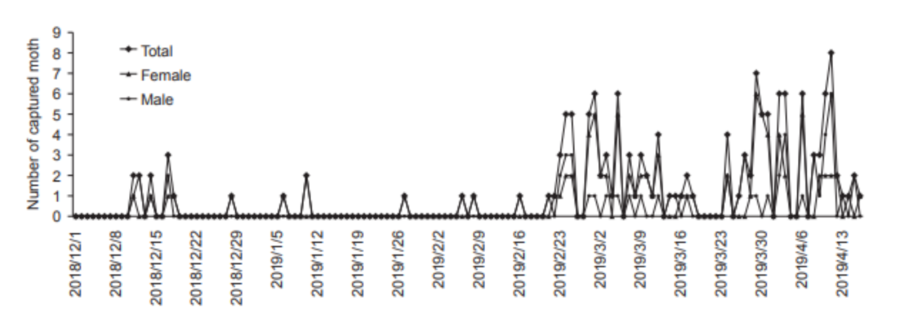The fall armyworm (FAW), scientifically known as Spodoptera frugiperda, has long posed a threat to the global agricultural sector due to its insatiable appetite for crops.
KNOXVILLE, TN, October 01, 2023 /24-7PressRelease/ — Originating from the tropical and subtropical regions of the Americas, FAW is notorious for damaging over 350 plant species, including staples such as corn, rice, and wheat. In its invasive expansions, FAW has caused yield losses of up to 73% in some areas. Given its destructive potential, tracking its migration has become paramount for ensuring food security.
Researchers from Chinese Academy of Agricultural Sciences set up a searchlight trap in March 2018 in Yunnan Province, China, a region known as the first stop for many pests coming from Southeast Asia. This monitoring process aimed to detect a possible FAW invasion into China. Moths captured that appeared suspicious were identified using DNA sequencing.
The results showed that the first FAW moth was captured on December 11, 2018, with a noticeable peak in its invasion by mid-December 2018. DNA sequencing revealed that the invaders were of the “corn-strain” variety, which is known to primarily feast on crops like corn, cotton, and sorghum. Field surveys confirmed that the pest had a particular preference for corn-growing regions in Pu’er, Dehong, and Baoshan. A migration trajectory analysis suggested that these moths largely originated from the eastern mid-latitude region of Myanmar. FAW’s arrival poses a significant threat to food production in China and East Asia. Data suggests that the initial wave of FAW entered China through air transport from the eastern side of Central Myanmar. This discovery underscores the urgent need for international cooperation on FAW management among East Asian nations. Due to the pest’s devastating impact, understanding its migration patterns is essential. This case study employed innovative methods, including molecular analysis and trajectory simulations, offering a reliable framework for monitoring future invasive species. This research pinpointed the first major influx of FAW into China in mid-December 2018. The early invaders, primarily of the “corn-strain” variety, established themselves in regions such as Pu’er, Dehong, and Baoshan. Furthermore, evidence suggests that the invasion’s epicenter might be in the eastern mid-latitude regions of Myanmar.
These findings provide invaluable insights into FAW’s migration dynamics in Asia and will be instrumental in formulating strategies to counteract this pest in China. Given the increasing threats from migratory pests due to global trade and climate change, the methods used in this study could serve as a benchmark for the early detection and management of other potential invasive species. It has proved that the accurate and timely prediction of FAW invasion provided important basis for secure agricultural production in China.
This study is published in Special Issue: Research on the invasive pest of fall armyworm (Spodoptera frugiperda) in China in Journal of Integrative Agriculture, Vol. 20 Issue 3, (https://www.sciencedirect.com/journal/journal-of-integrative-agriculture/vol/20/issue/3)
References
DOI
10.1016/S2095-3119(19)62839-X
Original Source URL
https://doi.org/10.1016/S2095-3119(19)62839-X
Funding information
The National Natural Science Foundation of China (31727901).
Journal
Journal of Integrative Agriculture
Chuanlink Innovations, where revolutionary ideas meet their true potential. Our name, rooted in the essence of transmission and connection, reflects our commitment to fostering innovation and facilitating the journey of ideas from inception to realization.
Related Link:
http://chuanlink-innovations.com
—
For the original version of this press release, please visit 24-7PressRelease.com here





